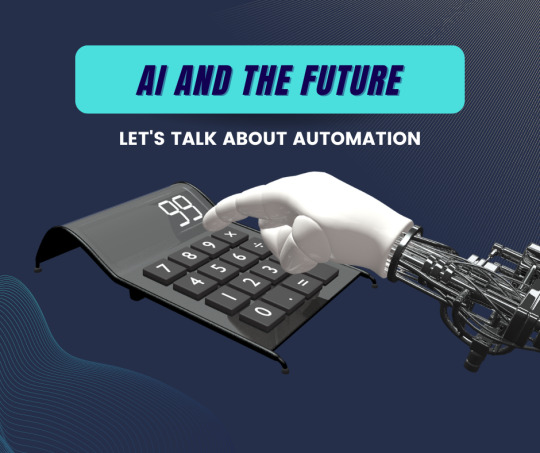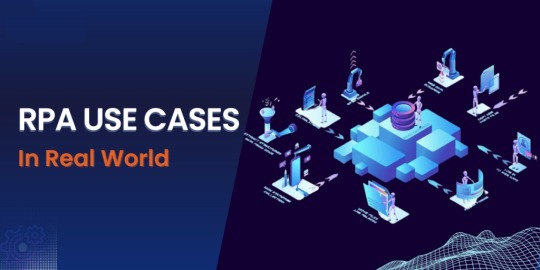#Robotic Process Automation in Retail
Explore tagged Tumblr posts
Text
Innovate with Confidence: RPA Solutions Tailored for Retail Success
Implementing RPA in inventory management benefits retailers with accurate inventory level tracing, demand and supply forecasting, as well as by streamlining communication, between all suppliers.
RPA software technology can benefit any retail organization with proper discovery, mapping, and deployment. The bots can be used for more than just tracking inventories, sending out notifications, and transferring data across systems.

Embrace innovation with RPA solutions designed for retail. Optimize inventory management, enhance efficiency, and stay ahead in the competitive landscape.
#inventory management analytics#retail inventory management#RPA solution for retail#RPA in retail Industry#RPA For Inventory Management#inventory management#RPA in inventory management#Inventory management in retail industry#RPA implementation#RPA service providers#rpa in retail management#use cases of rpa in retail#rpa in retail#Robotic Process Automation in Retail#rpa for retail#rpa in retail sector#Robotic Process Automation in Retail Industry#rpa retail#rpa case studies in retail#Robotic Process Automation in Trade Promotion
0 notes
Text
To Catch a Scammer
So, I just recently discovered that I had been speaking to a scammer who posed as a commission customer. Hopefully, by looking through my thought processes and mistakes, it will help others be smarter about conducting their own commissions.
For the ease of storytelling, I think it would be best for me to just go through what happened in chronological order.



So, first off, this person contacted me on March 20. Perhaps the red flags right off the bat are: 1.) Who really says "kindly" unless they're writing an essay or a super formal business letter, and 2.) the blank tumblr profile.
I even remember back then feeling a bit hesitant at the blank profile. Maybe I should have ignored the message right away. And with hindsight, I know that's what I should have done.
It makes you wonder: should the universal rule be that you always ignore requests from users with blank profiles?
Perhaps, but there are real people who do have blank profiles that aren't interested in conducting a scam. My partner is someone who doesn't post on Facebook or Instagram; in fact, his profiles are completely devoid of any pictures and info. He just uses them to follow his friends and coworkers.
So, what then? I think it's really up to you, but I'm personally going to ignore all requests from blank profiles.
I know that a common fear is, "what if I'm wrong, and I potentially ignored a real customer?"
To that, I would say that the possibility of having your time and effort wasted far outweighs the possibility of losing a customer. Thankfully, I didn't go through a lot of work on this scammer's job, but I still feel very upset that my time was wasted to begin with.
I also made the mistake of not reverse-image searching the profile picture, or the picture they sent me as reference, but more on that later.
Anyways, I did send them a message. I figured that I would get confirmation that they were a bot from the way they texted with me.


It seemed like they were responding to what I was actually asking. (So, perhaps this account was being run by a person, and not some automated program?)
My issue is that I tend to give people the benefit of the doubt. Working in retail has shown me that there are so many different kinds of people out in the world. Some who are reasonable and "normal," and some who are just plain weird, but you have to treat them as a customer all the same.
Not everyone responds in a detailed or personality-filled manner.
In fact, in my experience, I realized that's kind of an outlier. Most people tend to be very dry texters, or the type to just respond with as few words as possible. So, I didn't feel as though our subject, Nyben0001, was a robot right off the bat.
In the past, I had an experience with a scammer who disregarded all of my boundaries. They kept messaging me, "hello?" and "are you there?" even after I told them I was out of town and will not be available for business until I got back.
This "person" didn't hound me, and only responded when I did.
However, I think the lesson learned here is that you should not continue an interaction with a potential customer if their messages come across as overly dry and, in my opinion, unnecessarily brief.
One thing to note, which is something I didn't realize until later, was that this person appeared to be chronically online on Tumblr. (As indicated by the green dot) They are even "online" at the moment I'm typing this!
Sure, there are innocent reasons for that, but for a blank profile (no reblogs or anything) to always be online? I don't think so.

This wasn't my first time doing commissions online, and I thought that I put together a pretty good safeguard to weed out the potential scammers.
As mentioned in the screenshot, I created a Google Form for every potential customer to fill out. It wasn't just multiple choice answers; I required that they type out what they wanted from the commission. That way, I thought I'd be able to determine who was a real customer vs a bot or scammer. Any bot could just type in gibberish or something unrelated to the actual question.
All the questions were mandatory as well, so no one could get away with just sending a blank or partially filled out Form. I thought, surely a scammer didn't have the tools, interest, or patience to actually fill it out.
They actually did fill out my Form, which I thought was a very good sign. I'm going to include the unedited image because fuck this person.



Communication was then moved to email.


In hindsight, I should have been more put off by the one-word responses, but I've met a few people who treated emails almost as though they are text messages. They are usually the types who answer emails on their phone. One such person was my former 88-year old professor who I worked under. (Perhaps it's indicative of the actual age and identity of "Elena Mia"?)
This is where the real fuckery started.
I finished the sketches and asked for the first half of the payment to be sent through PayPal. ($7.50) This person then asked for my PayPal email despite being given the actual link to my PayPal page.

I've never had a customer ask me for that, but I honestly thought it was an innocent request. I know there is a discrepancy between the email I listed as my contact info, and the actual email associated with my account. I assumed they needed the email address to find my account on PayPal to send me the money.
You might be thinking, why wouldn't they just click on the link? In the moment, I thought that maybe I accidentally sent the wrong one, or that they felt uncomfortable clicking on some random link from a stranger. (Which I ironically sympathized with)
Most customers tend to pay me within an hour after receiving my Paypal information. Over 12 hours passed, and I got nothing.
That's when I started to worry, and I strongly suspected this was a scammer. I began feeling scared that this person asked me for my PayPal email, so they could try to hack it. I logged in to my PayPal and double checked that nothing was stolen, and none of the account activity seemed suspicious.
I slightly calmed down, then treated the situation as though I still was talking to a person.

Suspicious font change aside, I didn't receive any email notification that "Elena" paid me. PayPal always sends me an email whenever someone sends me money.
But, what I DID receive through my PayPal email was very interesting.

There's a lot going on, but let's point out all the suspicious details one at a time.
For starters, this is not PayPal's service email. I recognized that right off the bat because I DO receive legitimate emails from PayPal quite often. THIS is the email address PayPal uses.

Second, I did not receive any $7.50 payment from anyone called "Mara David." Third, who the fuck is Mara David? I thought I was talking to someone called Elena Mia?

Lastly, what even is this pea-brained issue that "PayPal" is claiming? So, if the situation is that Mara/Elena sent me $7.50, but PayPal can't process it because I don't have a business account, why in the ever loving HELL would the solution be that I pay HER $100? And, oh, when I DO pay her the $100, I'll somehow be paid back my $100 AND the $7.50 for the commission.
I'm at a loss for words at how stupid this scheme is.
The real icing on the cake was that "Nyben0001" actually left a comment for me yet AGAIN earlier today, March 25.

Makes you wonder if this person is just using a bot of some kind, otherwise, they literally forgot that they already contacted me, lmao.
I know it was unnecessary, but I then essentially told them to go fuck themselves. I honestly should have been meaner.

So, that's that. Good riddance to bad rubbish. Now, let's talk about safeguarding steps.
I mentioned near the beginning of the post that I didn't do any reverse-image searching. It honestly wasn't something that crossed my mind. But it definitely is a step that everyone should take if or when you feel suspicious about a person's profile.
These are the images I had to work with regarding this particular person. With hindsight, they do look like different people, but when you assume you're dealing with a real person, you overlook these things.
Even now, aside from the lighting, I wouldn't say they look like drastically different people.


For the first image, when I did a reverse-image search, this is what I found:


For the second image, this is what happened:



Very weird, huh? Maybe if I scrolled long enough, I'd find the original image with the denim jacket, but it's weird how there are no matches when I isolate the face.
My partner suggested that maybe these are AI images. There's nothing that overtly sticks out to me as AI from these pictures, but who really knows. This is one "smart" tactic from the scammer if so.
This is just one example, but I believe there are other scammers who will try the same thing, too. But, as you've seen, just because nothing pops up in the reverse image search, doesn't mean that the person is legit. Scammers, thankfully, have not learned how to actually sound like a real interested customer.
This is my takeaway from this particular situation:
1. Do not ever take work from someone with a blank/empty profile
2. If a potential customer asks YOU to message THEM about the job, there's a very good chance they are a scammer. The majority, if not all, the real customers I've had contacted ME privately first. There are some scammers who do contact you first, but either their profile, or the way they speak to you gives them away.
3. If the majority (I'd say at least 85%) of a person's replies are one-word answers, brief, or unprofessional for the setting, they are a scammer.
4. Do not ever give a customer your PayPal email. The page link should suffice.
5. You can try to reverse-image search their photos to verify their identity, but it honestly shouldn't come to this point if they have a blank profile. And, as you can see, it doesn't appear to be an accurate tell anymore.
6. I still think that the Google Form, or any other similar filter/buffer, is a good way to prevent scammers from ordering work from you. It seems like only the persistent ones are willing to get through it.
Personally, I think Number 1 and 2 are your best bets against protecting yourself from even opening communication with a scammer. Number 4 is also a dead giveaway.
I'd like to add that in my experience, scammers also ask if they can pay you with a check, or they'd make up some random excuse for why they can't use/access their PayPal, Venmo, Zelle, etc account. Don't you believe it!!
Please let me know of your own anti-scammer protection tips. I'd genuinely love to hear them!
#scammers#scam alert#scam warning#commission scams#online scams#scam#art scam#commission#art community#artists helping artists#artists supporting artists
7 notes
·
View notes
Text
Top B.Tech Courses in Maharashtra – CSE, AI, IT, and ECE Compared
B.Tech courses continue to attract students across India, and Maharashtra remains one of the most preferred states for higher technical education. From metro cities to emerging academic hubs like Solapur, students get access to diverse courses and skilled faculty. Among all available options, four major branches stand out: Computer Science and Engineering (CSE), Artificial Intelligence (AI), Information Technology (IT), and Electronics and Communication Engineering (ECE).
Each of these streams offers a different learning path. B.Tech in Computer Science and Engineering focuses on coding, algorithms, and system design. Students learn Python, Java, data structures, software engineering, and database systems. These skills are relevant for software companies, startups, and IT consulting.
B.Tech in Artificial Intelligence covers deep learning, neural networks, data processing, and computer vision. Students work on real-world problems using AI models. They also learn about ethical AI practices and automation systems. Companies hiring AI talent are in healthcare, retail, fintech, and manufacturing.
B.Tech in IT trains students in systems administration, networking, cloud computing, and application services. Graduates often work in system support, IT infrastructure, and data management. IT blends technical and management skills for enterprise use.
B.Tech ECE is for students who enjoy working with circuits, embedded systems, mobile communication, robotics, and signal processing. This stream is useful for telecom companies, consumer electronics, and control systems in industries.
Key Differences Between These B.Tech Programs:
CSE is programming-intensive. IT includes applications and system-level operations.
AI goes deeper into data modeling and pattern recognition.
ECE focuses more on hardware, communication, and embedded tech.
AI and CSE overlap, but AI involves more research-based learning.
How to Choose the Right B.Tech Specialization:
Ask yourself what excites you: coding, logic, data, devices, or systems.
Look for colleges with labs, project-based learning, and internship support.
Talk to seniors or alumni to understand real-life learning and placements.
Explore industry demand and long-term growth in each field.
MIT Vishwaprayag University, Solapur, offers all four B.Tech programs with updated syllabi, modern infrastructure, and practical training. Students work on live projects, participate in competitions, and build career skills through soft skills training. The university also encourages innovation and startup thinking.
Choosing the right course depends on interest and learning style. CSE and AI suit tech lovers who like coding and research. ECE is great for those who enjoy building real-world devices. IT fits students who want to blend business with technology.
Take time to explore the subjects and talk to faculty before selecting a stream. Your B.Tech journey shapes your future, so make an informed choice.
#B.Tech in Computer Science and Engineering#B.Tech in Artificial Intelligence#B.Tech in IT#B.Tech ECE#B.Tech Specialization
2 notes
·
View notes
Text

AI’s Role in Business Process Automation
Automation has come a long way from simply replacing manual tasks with machines. With AI stepping into the scene, business process automation is no longer just about cutting costs or speeding up workflows—it’s about making smarter, more adaptive decisions that continuously evolve. AI isn't just doing what we tell it; it’s learning, predicting, and innovating in ways that redefine how businesses operate.
From hyperautomation to AI-powered chatbots and intelligent document processing, the world of automation is rapidly expanding. But what does the future hold?
What is Business Process Automation?
Business Process Automation (BPA) refers to the use of technology to streamline and automate repetitive, rule-based tasks within an organization. The goal is to improve efficiency, reduce errors, cut costs, and free up human workers for higher-value activities. BPA covers a wide range of functions, from automating simple data entry tasks to orchestrating complex workflows across multiple departments.
Traditional BPA solutions rely on predefined rules and scripts to automate tasks such as invoicing, payroll processing, customer service inquiries, and supply chain management. However, as businesses deal with increasing amounts of data and more complex decision-making requirements, AI is playing an increasingly critical role in enhancing BPA capabilities.
AI’s Role in Business Process Automation
AI is revolutionizing business process automation by introducing cognitive capabilities that allow systems to learn, adapt, and make intelligent decisions. Unlike traditional automation, which follows a strict set of rules, AI-driven BPA leverages machine learning, natural language processing (NLP), and computer vision to understand patterns, process unstructured data, and provide predictive insights.
Here are some of the key ways AI is enhancing BPA:
Self-Learning Systems: AI-powered BPA can analyze past workflows and optimize them dynamically without human intervention.
Advanced Data Processing: AI-driven tools can extract information from documents, emails, and customer interactions, enabling businesses to process data faster and more accurately.
Predictive Analytics: AI helps businesses forecast trends, detect anomalies, and make proactive decisions based on real-time insights.
Enhanced Customer Interactions: AI-powered chatbots and virtual assistants provide 24/7 support, improving customer service efficiency and satisfaction.
Automation of Complex Workflows: AI enables the automation of multi-step, decision-heavy processes, such as fraud detection, regulatory compliance, and personalized marketing campaigns.
As organizations seek more efficient ways to handle increasing data volumes and complex processes, AI-driven BPA is becoming a strategic priority. The ability of AI to analyze patterns, predict outcomes, and make intelligent decisions is transforming industries such as finance, healthcare, retail, and manufacturing.
“At the leading edge of automation, AI transforms routine workflows into smart, adaptive systems that think ahead. It’s not about merely accelerating tasks—it’s about creating an evolving framework that continuously optimizes operations for future challenges.”
— Emma Reynolds, CTO of QuantumOps
Trends in AI-Driven Business Process Automation
1. Hyperautomation
Hyperautomation, a term coined by Gartner, refers to the combination of AI, robotic process automation (RPA), and other advanced technologies to automate as many business processes as possible. By leveraging AI-powered bots and predictive analytics, companies can automate end-to-end processes, reducing operational costs and improving decision-making.
Hyperautomation enables organizations to move beyond simple task automation to more complex workflows, incorporating AI-driven insights to optimize efficiency continuously. This trend is expected to accelerate as businesses adopt AI-first strategies to stay competitive.
2. AI-Powered Chatbots and Virtual Assistants
Chatbots and virtual assistants are becoming increasingly sophisticated, enabling seamless interactions with customers and employees. AI-driven conversational interfaces are revolutionizing customer service, HR operations, and IT support by providing real-time assistance, answering queries, and resolving issues without human intervention.
The integration of AI with natural language processing (NLP) and sentiment analysis allows chatbots to understand context, emotions, and intent, providing more personalized responses. Future advancements in AI will enhance their capabilities, making them more intuitive and capable of handling complex tasks.
3. Process Mining and AI-Driven Insights
Process mining leverages AI to analyze business workflows, identify bottlenecks, and suggest improvements. By collecting data from enterprise systems, AI can provide actionable insights into process inefficiencies, allowing companies to optimize operations dynamically.
AI-powered process mining tools help businesses understand workflow deviations, uncover hidden inefficiencies, and implement data-driven solutions. This trend is expected to grow as organizations seek more visibility and control over their automated processes.
4. AI and Predictive Analytics for Decision-Making
AI-driven predictive analytics plays a crucial role in business process automation by forecasting trends, detecting anomalies, and making data-backed decisions. Companies are increasingly using AI to analyze customer behaviour, market trends, and operational risks, enabling them to make proactive decisions.
For example, in supply chain management, AI can predict demand fluctuations, optimize inventory levels, and prevent disruptions. In finance, AI-powered fraud detection systems analyze transaction patterns in real-time to prevent fraudulent activities. The future of BPA will heavily rely on AI-driven predictive capabilities to drive smarter business decisions.
5. AI-Enabled Document Processing and Intelligent OCR
Document-heavy industries such as legal, healthcare, and banking are benefiting from AI-powered Optical Character Recognition (OCR) and document processing solutions. AI can extract, classify, and process unstructured data from invoices, contracts, and forms, reducing manual effort and improving accuracy.
Intelligent document processing (IDP) combines AI, machine learning, and NLP to understand the context of documents, automate data entry, and integrate with existing enterprise systems. As AI models continue to improve, document processing automation will become more accurate and efficient.
Going Beyond Automation
The future of AI-driven BPA will go beyond automation—it will redefine how businesses function at their core. Here are some key predictions for the next decade:
Autonomous Decision-Making: AI systems will move beyond assisting human decisions to making autonomous decisions in areas such as finance, supply chain logistics, and healthcare management.
AI-Driven Creativity: AI will not just automate processes but also assist in creative and strategic business decisions, helping companies design products, create marketing strategies, and personalize customer experiences.
Human-AI Collaboration: AI will become an integral part of the workforce, working alongside employees as an intelligent assistant, boosting productivity and innovation.
Decentralized AI Systems: AI will become more distributed, with businesses using edge AI and blockchain-based automation to improve security, efficiency, and transparency in operations.
Industry-Specific AI Solutions: We will see more tailored AI automation solutions designed for specific industries, such as AI-driven legal research tools, medical diagnostics automation, and AI-powered financial advisory services.
AI is no longer a futuristic concept—it’s here, and it’s already transforming the way businesses operate. What’s exciting is that we’re still just scratching the surface. As AI continues to evolve, businesses will find new ways to automate, innovate, and create efficiencies that we can’t yet fully imagine.
But while AI is streamlining processes and making work more efficient, it’s also reshaping what it means to be human in the workplace. As automation takes over repetitive tasks, employees will have more opportunities to focus on creativity, strategy, and problem-solving. The future of AI in business process automation isn’t just about doing things faster—it’s about rethinking how we work all together.
Learn more about DataPeak:
#datapeak#factr#technology#agentic ai#saas#artificial intelligence#machine learning#ai#ai-driven business solutions#machine learning for workflow#ai solutions for data driven decision making#ai business tools#aiinnovation#digitaltools#digital technology#digital trends#dataanalytics#data driven decision making#data analytics#cloudmigration#cloudcomputing#cybersecurity#cloud computing#smbs#chatbots
2 notes
·
View notes
Text
The Automation Revolution: How Embedded Analytics is Leading the Way

Embedded analytics tools have emerged as game-changers, seamlessly integrating data-driven insights into business applications and enabling automation across various industries. By providing real-time analytics within existing workflows, these tools empower organizations to make informed decisions without switching between multiple platforms.
The Role of Embedded Analytics in Automation
Embedded analytics refers to the integration of analytical capabilities directly into business applications, eliminating the need for separate business intelligence (BI) tools. This integration enhances automation by:
Reducing Manual Data Analysis: Automated dashboards and real-time reporting eliminate the need for manual data extraction and processing.
Improving Decision-Making: AI-powered analytics provide predictive insights, helping businesses anticipate trends and make proactive decisions.
Enhancing Operational Efficiency: Automated alerts and anomaly detection streamline workflow management, reducing bottlenecks and inefficiencies.
Increasing User Accessibility: Non-technical users can easily access and interpret data within familiar applications, enabling data-driven culture across organizations.
Industry-Wide Impact of Embedded Analytics
1. Manufacturing: Predictive Maintenance & Process Optimization
By analyzing real-time sensor data, predictive maintenance reduces downtime, enhances production efficiency, and minimizes repair costs.
2. Healthcare: Enhancing Patient Outcomes & Resource Management
Healthcare providers use embedded analytics to track patient records, optimize treatment plans, and manage hospital resources effectively.
3. Retail: Personalized Customer Experiences & Inventory Optimization
Retailers integrate embedded analytics into e-commerce platforms to analyze customer preferences, optimize pricing, and manage inventory.
4. Finance: Fraud Detection & Risk Management
Financial institutions use embedded analytics to detect fraudulent activities, assess credit risks, and automate compliance monitoring.
5. Logistics: Supply Chain Optimization & Route Planning
Supply chain managers use embedded analytics to track shipments, optimize delivery routes, and manage inventory levels.
6. Education: Student Performance Analysis & Learning Personalization
Educational institutions utilize embedded analytics to track student performance, identify learning gaps, and personalize educational experiences.
The Future of Embedded Analytics in Automation
As AI and machine learning continue to evolve, embedded analytics will play an even greater role in automation. Future advancements may include:
Self-Service BI: Empowering users with more intuitive, AI-driven analytics tools that require minimal technical expertise.
Hyperautomation: Combining embedded analytics with robotic process automation (RPA) for end-to-end business process automation.
Advanced Predictive & Prescriptive Analytics: Leveraging AI for more accurate forecasting and decision-making support.
Greater Integration with IoT & Edge Computing: Enhancing real-time analytics capabilities for industries reliant on IoT sensors and connected devices.
Conclusion
By integrating analytics within existing workflows, businesses can improve efficiency, reduce operational costs, and enhance customer experiences. As technology continues to advance, the synergy between embedded analytics and automation will drive innovation and reshape the future of various industries.
To know more: data collection and insights
data analytics services
2 notes
·
View notes
Text
Human vs. AI: The Ultimate Comparison & Future Possibilities

The debate of Human Intelligence vs Artificial Intelligence (AI) is one of the most important topics in today’s world. With AI advancing at an exponential rate, many wonder: Will AI surpass human intelligence? Can AI replace humans in creativity, emotions, and decision-making?
From self-driving cars to chatbots and even AI-generated art, artificial intelligence is rapidly transforming industries. But despite AI’s impressive capabilities, humans still have unique traits that make them irreplaceable in many aspects.
In this article, we will explore everything about Humans vs AI—how they differ, their strengths and weaknesses, and the possible future where both coexist.
What is Human Intelligence?
Human intelligence refers to the ability to think, learn, adapt, and make decisions based on emotions, logic, and experience. It is shaped by:
Cognitive Abilities: Problem-solving, creativity, critical thinking
Emotional Intelligence: Understanding and managing emotions
Adaptability: Learning from past experiences and adjusting to new situations
Consciousness & Self-Awareness: Understanding oneself and the impact of actions on others
Humans have common sense, emotions, and moral values, which help them make decisions in unpredictable environments.
What is Artificial Intelligence (AI)?
AI (Artificial Intelligence) is the simulation of human intelligence by machines. AI can process massive amounts of data and make decisions much faster than humans. The different types of AI include:
Narrow AI (Weak AI): AI specialized in specific tasks (e.g., voice assistants like Siri, Alexa)
General AI (Strong AI): AI with human-like reasoning and adaptability (not yet achieved)
Super AI: Hypothetical AI that surpasses human intelligence in every aspect
AI works on algorithms, machine learning (ML), deep learning (DL), and neural networks to process information and improve over time.
Strengths & Weaknesses of Human Intelligence
Strengths of Humans
Creativity & Imagination: Humans can create original art, music, inventions, and solutions.
Emotional Understanding: Humans can relate to others through emotions, empathy, and social skills.
Problem-Solving: Humans can solve problems in unpredictable and unfamiliar environments.
Ethical Reasoning: Humans can make moral decisions based on personal beliefs and societal values.
Adaptability: Humans can learn from experience and change their approach dynamically.
Weaknesses of Humans
Limited Processing Power: Humans take time to analyze large amounts of data.
Subjective Thinking: Emotions can sometimes cloud judgment.
Fatigue & Errors: Humans get tired and make mistakes.
Memory Limitations: Humans forget information over time.
Strengths & Weaknesses of AI
Strengths of AI
Fast Data Processing: AI can analyze vast datasets in seconds.
Accuracy & Precision: AI minimizes errors in calculations and predictions.
Automation: AI can perform repetitive tasks efficiently.
No Fatigue: AI doesn’t get tired and works 24/7.
Pattern Recognition: AI detects trends and anomalies better than humans.
Weaknesses of AI
Lack of Creativity: AI cannot create something truly original.
No Emotions or Common Sense: AI cannot understand human feelings.
Dependency on Data: AI needs large datasets to function effectively.
Security & Ethical Risks: AI can be hacked or misused for harmful purposes.
Job Displacement: AI automation can replace human jobs.
How AI is Impacting Human Jobs?
AI is automating many industries, raising concerns about job security. Some professions being replaced or transformed by AI include:
Jobs AI is Replacing
Manufacturing: Robots handle repetitive production tasks.
Retail & Customer Service: AI chatbots assist customers.
Transportation: Self-driving cars and delivery drones.
Jobs AI Cannot Replace
Creative Professions: Artists, writers, filmmakers.
Healthcare & Therapy: Doctors, nurses, psychologists.
Leadership & Management: Decision-making roles that require intuition.
The future will require reskilling and upskilling for workers to adapt to AI-driven jobs.
Can AI Surpass Human Intelligence?
Currently, AI lacks self-awareness, emotions, and real-world adaptability. However, advancements in Quantum Computing, Neural Networks, and AI Ethics may bring AI closer to human-like intelligence.
Some experts believe AI could reach Artificial General Intelligence (AGI), where it can think and learn like a human. However, whether AI will truly replace humans is still debatable.
Future of AI & Human Collaboration
The future is not about AI replacing humans but about AI and humans working together. Possible future scenarios include:
AI-Augmented Workforce: AI assists humans in jobs, increasing efficiency.
Brain-Computer Interfaces (BCI): AI could merge with human intelligence for enhanced cognition.
AI in Healthcare: AI helping doctors diagnose diseases more accurately.
Ethical AI Regulations: Governments enforcing AI laws to prevent misuse.
Rather than competing, humans and AI should collaborate to create a better future.
Conclusion
The battle between Human Intelligence vs AI is not about one replacing the other but about how they can complement each other. While AI excels in speed, accuracy, and automation, human intelligence remains unmatched in creativity, emotions, and moral judgment.
The future will not be AI vs Humans, but rather AI & Humans working together for a better society. By understanding AI’s capabilities and limitations, we can prepare for an AI-powered world while preserving what makes us uniquely human.
2 notes
·
View notes
Text
AI & IT'S IMPACT
Unleashing the Power: The Impact of AI Across Industries and Future Frontiers
Artificial Intelligence (AI), once confined to the realm of science fiction, has rapidly become a transformative force across diverse industries. Its influence is reshaping the landscape of how businesses operate, innovate, and interact with their stakeholders. As we navigate the current impact of AI and peer into the future, it's evident that the capabilities of this technology are poised to reach unprecedented heights.
1. Healthcare:
In the healthcare sector, AI is a game-changer, revolutionizing diagnostics, treatment plans, and patient care. Machine learning algorithms analyze vast datasets to identify patterns, aiding in early disease detection. AI-driven robotic surgery is enhancing precision, reducing recovery times, and minimizing risks. Personalized medicine, powered by AI, tailors treatments based on an individual's genetic makeup, optimizing therapeutic outcomes.
2. Finance:
AI is reshaping the financial industry by enhancing efficiency, risk management, and customer experiences. Algorithms analyze market trends, enabling quicker and more accurate investment decisions. Chatbots and virtual assistants powered by AI streamline customer interactions, providing real-time assistance. Fraud detection algorithms work tirelessly to identify suspicious activities, bolstering security measures in online transactions.
3. Manufacturing:
In manufacturing, AI is optimizing production processes through predictive maintenance and quality control. Smart factories leverage AI to monitor equipment health, reducing downtime by predicting potential failures. Robots and autonomous systems, guided by AI, enhance precision and efficiency in tasks ranging from assembly lines to logistics. This not only increases productivity but also contributes to safer working environments.
4. Education:
AI is reshaping the educational landscape by personalizing learning experiences. Adaptive learning platforms use AI algorithms to tailor educational content to individual student needs, fostering better comprehension and engagement. AI-driven tools also assist educators in grading, administrative tasks, and provide insights into student performance, allowing for more effective teaching strategies.
5. Retail:
In the retail sector, AI is transforming customer experiences through personalized recommendations and efficient supply chain management. Recommendation engines analyze customer preferences, providing targeted product suggestions. AI-powered chatbots handle customer queries, offering real-time assistance. Inventory management is optimized through predictive analytics, reducing waste and ensuring products are readily available.
6. Future Frontiers:
A. Autonomous Vehicles: The future of transportation lies in AI-driven autonomous vehicles. From self-driving cars to automated drones, AI algorithms navigate and respond to dynamic environments, ensuring safer and more efficient transportation. This technology holds the promise of reducing accidents, alleviating traffic congestion, and redefining mobility.
B. Quantum Computing: As AI algorithms become more complex, the need for advanced computing capabilities grows. Quantucm omputing, with its ability to process vast amounts of data at unprecedented speeds, holds the potential to revolutionize AI. This synergy could unlock new possibilities in solving complex problems, ranging from drug discovery to climate modeling.
C. AI in Creativity: AI is not limited to data-driven tasks; it's also making inroads into the realm of creativity. AI-generated art, music, and content are gaining recognition. Future developments may see AI collaborating with human creators, pushing the boundaries of what is possible in fields traditionally associated with human ingenuity.
In conclusion, the impact of AI across industries is profound and multifaceted. From enhancing efficiency and precision to revolutionizing how we approach complex challenges, AI is at the forefront of innovation. The future capabilities of AI hold the promise of even greater advancements, ushering in an era where the boundaries of what is achievable continue to expand. As businesses and industries continue to embrace and adapt to these transformative technologies, the synergy between human intelligence and artificial intelligence will undoubtedly shape a future defined by unprecedented possibilities.
20 notes
·
View notes
Text
🚀 What is AI in Automation, Key ApplicationsKey Applications
AI automation integrates AI techniques like machine learning and NLP to process data, make decisions, and improve traditional automation by enabling adaptability: ✅ RPA (Robotic Process Automation): Automates repetitive tasks like data entry. ✅ Manufacturing: Predictive maintenance, supply chain optimization, and quality control. ✅ Retail: AI chatbots enhance customer service with 24/7 support. ✅ Transportation & Logistics: AI streamlines supply chains and warehouse automation. ✅ Healthcare: AI improves diagnostics, patient monitoring, and robotic-assisted surgeries.

2 notes
·
View notes
Text
Wool Market Key Players, Trend, Analysis and Forecast to 2034
The global wool market is valued at around $35.25 billion in 2024 and is expected to grow significantly, reaching approximately $47.83 billion by 2034. This growth is fueled by several factors, including wool’s natural qualities, advancements in production technologies, and rising consumer demand for sustainable and eco-friendly materials.
Wool is a natural fiber known for its exceptional attributes—it is biodegradable, renewable, and naturally antibacterial, which makes it suitable for diverse applications. Its inherent fire resistance and excellent thermal insulation further boost its popularity, especially in sectors like fashion apparel and interior textiles. Thanks to its versatility, wool is used across a broad spectrum of products, ranging from luxury fashion items and home furnishings to specialized technical textiles.
𝐃𝐨𝐰𝐧𝐥𝐨𝐚𝐝 𝐚 𝐒𝐚𝐦𝐩𝐥𝐞 𝐂𝐨𝐩𝐲 𝐨𝐟 𝐓𝐡𝐢𝐬 𝐑𝐞𝐩𝐨𝐫𝐭: https://www.factmr.com/connectus/sample?flag=S&rep_id=10076
Technological Advancements in Wool Production
Recent advancements in wool production techniques have significantly contributed to market expansion. Modern processes have enhanced the quality and efficiency of wool processing, leading to improved products with reduced environmental impact. Innovations such as digital shearing, automated sorting systems, and enhanced dyeing methods have all bolstered productivity. Additionally, the adoption of sustainable and eco-friendly production practices has resonated positively with environmentally conscious consumers, driving up demand.
Market Insights by Country
In Japan, the wool market is projected to grow at a CAGR of 2.8% from 2024 to 2034.
In the United States, the increasing reliance on online shopping within the garment industry is a key driver of market growth. This trend is fueled by the widespread use of smartphones and the expansion of e-commerce giants like Amazon, eBay, Otto, Walmart, Priceline, and Alibaba.
Digital innovation, globalization, and shifts in consumer purchasing behaviors are anticipated to propel the fashion industry forward. Online commerce offers a broader range of product options and competitive pricing compared to traditional retail outlets. Furthermore, the convenience of payment methods and the availability of home delivery options contribute significantly to industry growth. The widespread availability of internet platforms in the U.S. facilitates efficient acquisition of goods by manufacturers and suppliers alike.
Category-Based Evaluation
Based on application, interior textiles are estimated to account for 31.5% of the wool market in 2024.
Wool is frequently used in apparel, such as coats and other winter items, due to its high warmth retention capabilities. As winter comes, a big number of individuals purchase woolen garments to protect themselves from the chilly winds, driving up global demand for wool apparel.
Business Competition
The worldwide wool market is highly fragmented, with various country-level businesses addressing local client demand. Despite their long history, wool market participants face a reduction in wool production and the rapid introduction of less expensive and more adaptable synthetics and other natural materials into end-use industries.
As rapid wool shearing remains an important factor in improving wool output, market participants are turning their attention to robotic shearing and other technologies to stay competitive. Key companies in the wool market are adapting to new market trends, such as insulating mineral wool and other knitted materials.
𝐑𝐞𝐚𝐝 𝐌𝐨𝐫𝐞: https://www.factmr.com/report/wool-market
Key Segments of Wool Market Research
By Source:
Merino Wool
Peruvian Highland Wool
Teeswater Wool
Shetland Wool
Cashmere Wool
Others
By Type:
Fine Wool
Medium Wool
Coarse Wool
By Application:
Apparel
Interior Textiles
By Region:
North America
Latin America
Western Europe
Eastern Europe
East Asia
South Asia & Oceania
Middle East & Africa
𝐊𝐞𝐲 𝐏𝐥𝐚𝐲𝐞𝐫𝐬: Laxtons Limited, Suedwolle Group Italia, Indorama Ventures Public Company Limited, Suripi Textiles Pvt. Ltd., Sharman Woolen Mills Ltd, Jainson Hosiery Industries, Shanghai Kunlei Wool Textile Co., Rockwool International, Johns Manville, Owens Corning, Saint-Gobain, Paroc Group Oy.
𝐂𝐨𝐧𝐭𝐚𝐜𝐭:
US Sales Office 11140 Rockville Pike Suite 400 Rockville, MD 20852 United States Tel: +1 (628) 251-1583, +353-1-4434-232 Email: [email protected]
1 note
·
View note
Text
Cloud AI Market Growth: Key Applications, Opportunities, and Industry Outlook 2032
Introduction
The global Cloud AI Market is experiencing unprecedented growth, driven by the increasing demand for artificial intelligence (AI) capabilities on cloud platforms. As businesses across various industries embrace AI-driven automation, predictive analytics, and machine learning, cloud-based AI solutions are becoming indispensable. This article provides an in-depth analysis of the Cloud AI Market, its key segments, growth drivers, and future projections.
Cloud AI Market Overview
The Cloud AI Market has witnessed rapid expansion, with an estimated compound annual growth rate (CAGR) of 39.6% from 2023 to 2030. Factors such as the adoption of AI-driven automation, increased investment in AI infrastructure, and the proliferation of cloud computing have fueled this surge.
Request Sample Report PDF (including TOC, Graphs & Tables): www.statsandresearch.com/request-sample/40225-global-cloud-ai-market
What is Cloud AI?
Cloud AI refers to the integration of artificial intelligence tools, models, and infrastructure within cloud-based environments. This includes AI-as-a-service (AIaaS) offerings, where businesses can leverage machine learning, deep learning, and natural language processing (NLP) without the need for extensive on-premise infrastructure.
Cloud AI Market Segmentation
By Technology
Deep Learning (35% Market Share in 2022)
Used for image recognition, speech processing, and advanced neural networks.
Key applications in autonomous vehicles, healthcare diagnostics, and fraud detection.
Machine Learning
Supports predictive analytics, recommendation engines, and automated decision-making.
Natural Language Processing (NLP)
Powers chatbots, sentiment analysis, and voice assistants.
Others
Includes AI algorithms for robotics, cybersecurity, and AI-driven optimization.
Get up to 30% Discount: www.statsandresearch.com/check-discount/40225-global-cloud-ai-market
By Type
Solutions (64% Market Share in 2022)
Cloud-based AI solutions offered by major tech players like Amazon, Microsoft, and Google.
Includes AI-powered SaaS platforms for various industries.
Services
AI consultation, implementation, and support services.
By Vertical
IT & Telecommunication (Dominated Market in 2022 with 19% Share)
AI-driven network optimization, cybersecurity, and data management.
Healthcare
AI in medical imaging, diagnostics, and drug discovery.
Retail
AI-driven recommendation systems and customer analytics.
BFSI (Banking, Financial Services, and Insurance)
Fraud detection, risk management, and automated trading.
Manufacturing
Predictive maintenance, AI-powered robotics, and supply chain optimization.
Automotive & Transportation
Autonomous vehicles, AI-powered traffic management, and fleet analytics.
Cloud AI Market Regional Insights
North America (32.4% Market Share in 2022)
Home to leading AI and cloud computing companies like Google, IBM, Microsoft, Intel.
Early adoption of AI in healthcare, finance, and retail.
Asia-Pacific
Rapid digital transformation in China, Japan, India, and South Korea.
Government initiatives supporting AI research and development.
Europe
Strong presence of AI startups and tech firms.
Increasing investment in cloud-based AI solutions.
Middle East & Africa
Growing adoption of AI in smart cities, banking, and telecommunications.
Rising interest in AI for government services.
South America
Expansion of AI-driven fintech solutions.
Growth in AI adoption within agriculture and retail sectors.
Competitive Landscape
Key Cloud AI Market Players
Apple Inc.
Google Inc.
IBM Corp.
Intel Corp.
Microsoft Corp.
NVIDIA Corp.
Oracle Corp.
Salesforce.com Inc.
These companies are investing heavily in AI research, cloud infrastructure, and AI-powered services to gain a competitive edge.
Cloud AI Market Growth Drivers
Increasing Adoption of AI-as-a-Service (AIaaS)
Businesses are leveraging cloud AI solutions to reduce infrastructure costs and scale AI models efficiently.
Advancements in Deep Learning and NLP
Innovations in conversational AI, chatbots, and voice recognition are transforming industries like healthcare, retail, and finance.
Rising Demand for AI-Driven Automation
Organizations are adopting AI for workflow automation, predictive maintenance, and personalized customer experiences.
Expansion of 5G Networks
5G technology is enhancing the deployment of AI-driven cloud applications.
Cloud AI Market Challenges
Data Privacy and Security Concerns
Strict regulations such as GDPR and CCPA pose challenges for cloud AI implementation.
High Initial Investment
While cloud AI reduces infrastructure costs, initial investment in AI model development remains high.
Skills Gap in AI Talent
Organizations struggle to find skilled AI professionals to manage and deploy AI applications effectively.
Future Outlook
The Cloud AI Market is set to grow exponentially, with AI-driven innovation driving automation, predictive analytics, and intelligent decision-making. Emerging trends such as edge AI, federated learning, and quantum computing will further shape the industry landscape.
Conclusion
The Cloud AI Market is a rapidly evolving industry with high growth potential. As companies continue to integrate AI with cloud computing, new opportunities emerge across various sectors. Organizations must invest in cloud AI solutions, skilled talent, and robust security frameworks to stay competitive in this dynamic landscape.
Purchase Exclusive Report: www.statsandresearch.com/enquire-before/40225-global-cloud-ai-market
Contact Us
Stats and Research
Email: [email protected]
Phone: +91 8530698844
Website: https://www.statsandresearch.com
1 note
·
View note
Text
The Future is Now: How AI and Automation Are Revolutionizing 2024
Find out how AI and automation are reprogramming industries and people’s lives in the year 2024. Our text covers the most pressing issues, brand new concepts, and implications for the human resources field in this context. H1: Introduction:
Introduction to AI and automation Appreciating the changes and how not keeping up would be futile. H2: Growing Use of AI in 2024: On the growth in adoption of AI within sectors Artificial intelligence-derived technological interventions

H3: Automation within the Constraints of a Busy Schedule; The background of the issue of doing day-to-day activities faster and easier The era of smart homes and personal assistants is here, and society is embracing it. H3: Employment of the AI and the Automation: Effect of AI and Automation on The Enrichment of Jobs The Emergence of New Types of Occupations. H2: Top 5 Industries Revolutionized by AI at Present: 1. Healthcare 2. Manufacturing 3. Finance 4. Retail 5. Education H3: Use of AI for Enhancing Health Systems: AI that predicts and develops recommendations and plans for treatment Roles played by robots when it comes to surgery processes
H3: AI in the Manufacturing Industry: The Future of Manufacturing: Smart Factories Preferably with Robotism, Automated Warehouses, etc. Conclusion: Other aspects eased by modern technologies H3: AI’s Impact on Finance: This Part Demonstrates the Influence of AI on Financial Activities Facilitated by Artificial Instrumental Advantages. For instance, telemarketing correspondent inquiries. H3: AI in Retail: The configuration of retail strategy and value chain strategy is reflected in the adjusted supply chain architecture. In Conclusion. H3: AI in Education: Extends to current applications of AI in education..
Be informed, Be ahead! Click here join World News Update and always be informed of the progress in... AI.
Benefits and Costs: Current Challenges: Possibilities of Job Losses and the Skills Required H2: AI and Automation in the Near Future: Prospects and Possibilities for the Next Five Years Improving firms in incorporation of these concepts in the industry. The SWOT
H2: Conclusion:
Summarizes the impact of AI and automation within the context of ‘2024’. What should be done and what is to be done next? H2: FAQs: What about the question regarding automation—how it is changing the employment sector? Can technology ever fully eradicate the need for human workers?
What are the common functions that, however, are these days being performed by automated labor? What are the opportunities that technology offers, especially for independent enterprises? What skills do people should acquire or develop to have a chance of being effective at work? Introduction.

Everyone has been and is hearing a lot of talk about self-driving cars and robots taking over people's work for a few years now. However, as crazy as the idea of them is, in 2024 it is no longer just things we hear; they are actually happening. Everything from turning around businesses to finding a place to sleep at night, there is no doubt about it that these advancements are changing everything we know about the world. Therefore, changes like this are very important.
For this paper, we will expound on the revolutionary ways through which artificial intelligence as well as automation is taking a grip of the year 2024, the sectors most hit, and what features the future will bring. Shall we begin?
Do Not Let the AI Wave Get You Thin! Subscribe with World News Update for a more comprehensive cover on ai.
The Evolution of AI in 2024: Considering the way artificial intelligence has grown, its impact in 2024 is. Not even at the present could these industries and the advancement in AI afford to be separated. Important Breakthroughs in AI: Artificial intelligence is now not a thing of the past, for it is advancing right in 2024 from the point of sophistication and attention. AI assistive technology has revolutionized many a task. Automation of Everyday Businesses: Not only our economic perspective alters with the present progression toward automation but also other aspects of our lives. It’s true even for children’s toys. The Emergence of High-Tech Homes and Robo-Manservant: Think of being back in your house all day only to find out that your house knows all that stuff and even knows the choice of the music that you love playing. With smart houses, it is no longer a figure of speech. It is social reality. Alexa and Google Assistant are ever-present smart helpers in our habits and routines, allowing us to organize our day-to-day routine in a more efficient way.
Partake in the Age of Artificial Intelligence! click and join Health Tips by 90s Mantor0 and literary be at the edge of the sea in terms of AI and automation. The Future of Employment: There is no doubt that the ways in which work is done have been dramatically changed due to technology. Therefore, what was being done by hand in the past is today done by machines. Current and emerging trends on AI and its impacts on the job market; Robots are being used more and more for routine activities, which humans can then stop doing and start on other tasks that are more stimulating or more strategic. For such employees, they should not only be open to such opportunities and paths but should offset the tremendous technological advances that continue to require people to seek new skills and competencies to remain employable. The Top 5 Sectors That Are About to Experience a Revolution As a Result of AI Now it is time to consider the use of AI and automation in specific sectors: 1. Medication Industry: The field of medicine is currently being revolutionized by AI, which aims at creating backing for the work of doctors and also to benefit patients. AI-Driven Diagnostics and Treatment Schemes: AI has the ability to diagnose patients better and more accurately in a fraction of human performance time. Therefore, it can be used to deliver diagnostics and treatment plans to the place where the patients are in real-time. The Role of Robots in Surgery:
The practice of robotic surgery has gained popularity as it assists in making accurate cuts and reduces the recovery period and healing process. 2. Production: Artificial intelligence has also been introduced in industries to make the manufacturing process faster. Smart factories and automated robots. The factories have the artificial intelligence-programmed robots doing works such as quality inspection and assembling and also carrying out predictive maintenance strategies that ensure all the machines are up all day long. 3. Finance: The financial sector has made a step in the integration of artificial intelligence, ranging from auto-trading to fraud detection and even risk management. AI-driven trading platforms: These computer programs can process a lot of data much faster than the human brain and make decisions in split seconds for quite profitable trades in the financial markets while reducing the chances of human intervention errors. 4. Retail: It's no mystery that AI is having a massive influence on modern-day retail by enhancing consumer pleasure and hands-free inventory approaches. Personalized Shopper Experience Retailers are leveraging AI to make hyper-personal product suggestions; this ensures that customers always enjoy unique buying encounters based on the details available about them. 5. Education: AI is used to provide tailored learning experiences in education by assisting students and educators in the process of implementing education according to the specifics of students’ individual abilities and needs. AI: A Crucial Component in the Learning Process: Gone are the days when a teacher would have to explain first, then organize tasks and correct, then/or thereafter feed students information. Thanks to AI, a teacher can tell where all the students are stuck and, without struggling, give each student a lesson tailored to address what problem he or she may be having at that particular time. Advantages and disadvantages of AI and automation: Nevertheless, AI and automation have some weaknesses as well. Operating Cost Effectiveness and Time Savings By using AI, companies can get busy with scaled activities while still doing repetitive work of the staff. At the same time, it offers the improvement of the company’s operations as well as considerably lower inputs. Future Work and Age-Related Job Loss Occurred along with the Skills Lost One of the negative consequences of this is also the fear that dynamic changes in the area of AI quite often result in job understating. AI with Automation in the Near Future: The following question pertains to the future of AI and how long people will learn and actually utilize it. What will happen in the next few years? If more capabilities of AI technology are used—this one even more in such areas as health, industry, and finance. We may also experience autonomous vehicles, smart cities, and AI-driven infrastructure components working at the core of everyday life. Trends and Technologies on the Rise: Most of the up-and-coming fads revolve around the more advanced development of quantum computing and the concepts of ethics surrounding the applications of AI to adjust it in a way that is of significant advantage to everyone’s wellbeing. In conclusion.
Read more>>>>>>>>>>
#AI in 2024#automation trends#artificial intelligence#future of work#smart technology#impact of AI#automation in industry.
3 notes
·
View notes
Text
RPA Case Studies in Retail: Real-World Examples of RPA Success
Get inspired by real-world success stories of retailers using RPA. See how RPA is driving tangible results and transforming business operations. Today, customers expect a faster and flawless shopping experience with an upcoming attitude toward automated checkout.

To put this in perspective, Robotic Process Automation (RPA) In Retail Industry is the perfect answer to tackle various challenges like reducing operational costs with increased efficiency, and customers’ expectations.
#rpa in retail management#use cases of rpa in retail#rpa in retail#Robotic Process Automation in Retail#rpa for retail#rpa in retail sector#Robotic Process Automation in Retail Industry#rpa retail#rpa case studies in retail#Robotic Process Automation in Trade Promotion#RPA solution for retail#RPA in retail Industry
0 notes
Text
Emergency Services See Improved Response Management Thanks to AI
New Post has been published on https://thedigitalinsider.com/emergency-services-see-improved-response-management-thanks-to-ai/
Emergency Services See Improved Response Management Thanks to AI


Down the street, a fire erupts and sensors alert authorities before you dial the phone. Across the world, police officers leverage AI-powered imaging to protect citizens in a new way. AI is going to start appearing in more places that matter. Emergency services are leveraging AI tools to bolster staffing, intelligence, and response times to serve better and faster. How does this manifest in each sector to deliver people the aid they need as quickly and efficiently as possible?
1. Law Enforcement
Police officers are working in unprecedented crime climates. Incident types are shifting, and everything is digital. AI improves response management for law enforcers in a medley of ways.
Investigative Support and Data Documentation
Paperwork is the bane of law enforcement workforces. Automating this process with AI relieves tedious work hours from staff, leaving them more time to be attentive to victims and solve cases. AI’s natural language processing makes it adept at sifting through massive amounts of text, providing actionable and coherent insights for emergency response personnel.
AI can also work alongside investigators to identify crime patterns and solve cases by noticing hotspots or cross-referencing city databases for background checks. The technology can also track cellphone signals and serial numbers to scan activity, so long as it is employed ethically. These use cases have been used for theft prevention measures in retail outlets, allowing police to report to the scene faster with automated alerts.
Predictive Policing Analytics and Prevention
Machine learning algorithms train from a police department’s history and compare that to the world’s crime trends. Split-second determinations permit officers to have a working crime forecast to prepare for and defend against unique threats accordingly.
The investigative support will translate to courtrooms as AI might become pivotal in sentencing and rehabilitation efforts. The vast databases provide more accurate, less biased decisions and curate recovery methods to lower recidivism. It requires supervision over data stores to eliminate anomalies and hallucinations, but it is possible.
Smart Video Surveillance
First responders use AI to gather real-time footage and analytics to shorten response times. Local events like parades and protests should have additional support with remote AI video surveillance. Additionally, smart video uses facial recognition.
The technology is still growing in accuracy, and the ethics surrounding likeness scanning for AI learning is up for debate. However, deploying intelligent cameras makes tracking missing persons and threat actors easier.
2. Fire and Rescue Services
Firefighters have spent years perfecting a swift exit to locations in dire need. How could AI make their response management even cleaner, quicker and safer?
Intelligent Dispatch Systems
Determining how many responders to send on a job is a balancing act. Dispatch teams must consider weather, geography, and compliance when packing vehicles with supplies and staff. Stressful circumstances cause human error and oversights, but it would happen less frequently with AI.
In operations centers, AI works best in tandem with the human element. AI helps human operators allocate resources responsibly, leveraging smart systems to ensure everything is accounted for, no matter where you are.
Robot-Powered Search and Rescue
Drones fly over an area destroyed by a fire and debris is everywhere. AI and geographic information systems (GISs) scan thick piles of rubble and infrastructure to quickly identify people needing help. AI determinations could deliver solutions for extricating them safely.
Entities like the U.S. Coast Guard benefit greatly from AI-powered aerial devices to trace mariner distress signals without wasting excess fuel on the wrong trajectory. Remote crafts with AI knowledge travel to those in trouble, delivering essentials and beginning recovery.
3. Emergency Medical Services
EMS personnel have a lot to juggle in a speeding car. They must stabilize patients amid frenzied explanations about what happened, keeping them stable long enough to reach the hospital. The likelihood of safe delivery improves with AI’s help.
Triage and Diagnosis
Emergency rooms are chock-full of people in distress, usually assigned long wait times while personnel determine condition status. AI triage scans a patient’s medical history against existing knowledge to find an ideal treatment for their body and circumstances.
The technology looks at biomarkers against clinical decision trees for increased awareness of the patient’s condition. It allows for personalized medical care by considering more factors than an emergency doctor’s potentially limited knowledge of an individual.
Telemedicine and Virtual Assistants
AI-powered virtual assistance and telemedicine are even more popular for prescreening patients, doing tedious documentation tasks and providing initial medical advice. The practical and emotional implications of this in emergency services are profound, as it makes people feel more tended to while they wait for doctors. It provides some answers almost immediately while expediting the check-in process.
4. Natural Disaster Management
The climate crisis is exacerbating the frequency and severity of extreme weather. Geographies that have never seen snow are experiencing power outages due to storms. Desert climates see sandstorms lengthen in average duration. Private and government-founded natural disaster response services can use AI for early warning systems.
Disaster Detection and Alerts
AI is successful in melding with meteorological resources to forecast disastrous weather events. Sensors, satellites and more recognize region-specific seismic response and precipitation patterns.
Overseeing entities then notify constituents how to prepare safely, and many can even send automated emergency notifications to connect residences with best actions through mediums like social media chatbots. The algorithm could predict everything from an earthquake to a budding hurricane.
Evacuation
New technologies would even be able to curb stress from evacuations. Researchers performed simulations to see how well AI could minimize traffic inundation by predicting which areas would flood the fastest. The models worked with 98% precision, revealing an expedient way to evacuate citizens with less stress.
5. Emergency Animal Health Services
You have seen how EMS teams employ AI to help people, but what about animals? They can get into critical situations on roadsides or hiking trails. What about if a wildfire strikes your ranch and you must worry about your livestock? How can AI get emergency veterinary care out in time to these sometimes remote locations?
Regional Awareness
Citizens can notify park rangers and local departments to monitor susceptible species and areas. AI is critical for immediate diagnosis. It is more effective at identifying treatment options while preventing the spread of biological hazards and infectious diseases transmitted through animals.
Endangered Species and Conservation
AI might have an unexpected role in veterinary emergency response by conserving endangered species. AI can locate, track and study even the most elusive animals that need protecting. Conservationists and emergency veterinary teams can better serve their animals with geofencing and infrared cameras. At Lake Itezhi-Tezhi in Zambia, systems collect data while eliminating overfishing and ivory poaching by over 50% in the region.
AI to the Rescue
Emergency services are in a new erratic era of care. The COVID-19 pandemic shifted how people interact with medical assistance. Digitization has altered how much crime happens in cyber spheres instead of physical spaces. Everyone has to scale operations to cover bases holistically, and AI can help.
AI-powered emergency response improves daily as the technology’s expertise grows, leading to a future of fewer disasters, healthier people and safer communities.
#Advice#ai#AI-powered#algorithm#Algorithms#Analytics#Animals#awareness#background#bases#biomarkers#Cameras#chatbots#climate#climate crisis#compliance#covid#crime#cyber#data#databases#debris#detection#devices#Disaster response#Diseases#earthquake#employed#EMS#Ethics
2 notes
·
View notes
Text
Material Handling Equipment Market Insights, Future Trends, On-going Demand, Opportunities (2021-2031)
The Material handling equipment market size is expected to reach US$ 92.63 billion by 2031 from US$ 60.05 billion in 2024. The market is estimated to record a CAGR of 6.51% from 2025 to 2031.
Executive Summary and Global Market Analysis
The global material handling equipment market is demonstrating vigorous growth, fundamentally driven by rapid industrialization, the growing imperative for warehouse automation, and the flourishing e-commerce sector. This market encompasses a comprehensive range of machinery crucial for the seamless movement, storage, control, and protection of materials across manufacturing, distribution, and disposal processes. The market's trajectory is primarily fueled by a pressing need for enhanced operational efficiency, the increasing integration of sophisticated automation technologies, and a vital demand for greater supply chain transparency. In direct response to these evolving market requirements, manufacturers of material handling equipment are developing innovative solutions that leverage advanced technologies such as artificial intelligence (AI), the Internet of Things (IoT), and robotics to optimize warehouse operations and strengthen logistics infrastructure. Asia-Pacific continues to maintain its strong market leadership, primarily due to significant infrastructure investments and rapid urbanization observed in key countries like China and India.
Download our Sample PDF Report
@https://www.businessmarketinsights.com/sample/BMIPUB00031690
Material Handling Equipment Market Drivers and Opportunities
The extraordinary growth of e-commerce serves as a powerful driver for the material handling equipment market. With the continuous surge in online retail activities, leading companies such as Amazon and Alibaba are extensively investing in automated warehouse solutions to effectively manage vast order volumes. This, in turn, directly stimulates significant demand for essential equipment including forklifts, conveyors, and Automated Guided Vehicles (AGVs). Furthermore, the combined effects of accelerating urbanization and consumers' increasing demands for rapid delivery services intensify the need for highly efficient logistics systems. The robust development of warehousing infrastructure across crucial regions like Asia-Pacific and North America directly propels sales of material handling equipment. As the e-commerce wave continues its strong momentum, the imperative for advanced material handling solutions to streamline operations and significantly reduce delivery times will act as a major catalyst for sustained market expansion.
Material Handling Equipment Market Size and Share Analysis
By Equipment Type
Key segments include Cranes and Lifting Equipment, Industrial Trucks, Automated Storage and Retrieval Systems (AS/RS), Conveying Systems, Racking and Storage Equipment, Automated Guided Vehicles (AGVs), Bulk Material Handling Equipment, and Others. Cranes and lifting equipment are indispensable across construction, manufacturing, heavy engineering, automotive, and logistics sectors for the efficient transfer of heavy materials and payloads. The construction industry, in particular, generates significant demand due to ongoing urbanization, substantial infrastructure development, and large-scale industrial projects.
By End-User Industry
The global increase in automobile production necessitates robust material handling systems to manage the smooth flow of materials and finished vehicles within manufacturing facilities and distribution hubs. Automotive plants are increasingly adopting modern material handling infrastructure to enhance assembly line efficiency, cut down turnaround times, and support lean manufacturing principles—all requiring advanced handling equipment. The automotive sector's embrace of automation, robotics, and IoT-enabled material handling solutions improves both operational efficiency and safety, consequently boosting demand for sophisticated equipment.
Material Handling Equipment Market Segmentation Analysis
The in-depth analysis of the material handling equipment market is defined by key segmentation across technology, material, application, and end user.
By Equipment Type, the market is classified into:
Cranes and Lifting Gear
Industrial Trucks
Automated Storage and Retrieval Systems (AS/RS)
Conveyance Systems
Racking and Storage Apparatus
Automated Guided Vehicles (AGVs)
Bulk Material Handling Machinery
Miscellaneous Equipment Types
By End-Use Industry, the market segments include:
Logistics
Automotive
Construction
Food & Beverages
Pharmaceuticals/Healthcare
Semiconductor & Electronics
By Application Type, the market considers:
Assembly Processes
Transportation Tasks
Distribution Functions
Other Applications
About Us:
Business Market Insights is a market research platform that provides subscription service for industry and company reports. Our research team has extensive professional expertise in domains such as Electronics & Semiconductor; Aerospace & Defense; Automotive & Transportation; Energy & Power; Healthcare; Manufacturing & Construction; Food & Beverages; Chemicals & Materials; and Technology, Media, & Telecommunications
0 notes
Text
Choosing the Right Pallet Conveyor Manufacturer: What to Look For
In today’s fast-paced industrial landscape, pallet conveyors play a critical role in ensuring seamless material handling, especially in warehouses, logistics centers, and manufacturing facilities. Choosing the right pallet conveyor manufacturer is not just about sourcing equipment—it's about partnering with a company that understands your operational goals, offers reliable solutions, and supports you throughout the lifecycle of your system.
What Are Pallet Conveyors?
Pallet conveyors are material handling systems designed to move heavy or large items placed on pallets. These conveyors are typically used for:
Automated warehouse systems
Manufacturing and assembly lines
Food and beverage logistics
Distribution centers
They can handle loads ranging from a few hundred kilograms to several tons, making them essential for heavy-duty industrial use.
Why Manufacturer Selection Matters
Choosing the right manufacturer can impact everything from operational efficiency to downtime, energy usage, and safety compliance. Here's why your decision matters:
Customization: A reliable manufacturer can tailor conveyor systems to your facility layout, load requirements, and workflow needs.
Quality and Durability: Top manufacturers use high-grade materials and engineering practices to ensure longevity.
After-Sales Support: Installation, maintenance, and service support are vital for keeping systems running smoothly.
Compliance: Trustworthy manufacturers ensure their products meet safety and regulatory standards (e.g., CE, ISO certifications).
Key Features to Look for in a Pallet Conveyor Manufacturer
Here are the must-have qualities in a manufacturer:
1. Proven Industry Experience
Choose a manufacturer with a solid track record in designing and installing pallet conveyor systems for your industry. Look for case studies or client testimonials.
2. Custom Engineering Capabilities
Every facility has unique needs. The best manufacturers offer tailored systems, including:
Roller conveyors
Chain-driven conveyors
Turntables and transfer units
Automated pallet handling systems
3. Smart Integration Options
Modern pallet conveyors should integrate with:
Warehouse Management Systems (WMS)
ERP platforms
Robotic palletizers and automated guided vehicles (AGVs)
4. Energy Efficiency
Sustainability is more than a buzzword. Choose a manufacturer that uses energy-efficient motors and low-maintenance components to reduce your operational costs.
5. Support & Maintenance Services
From installation to long-term service contracts, after-sales support ensures less downtime and better performance over time.
Top Applications of Pallet Conveyors
Automotive Assembly Lines
E-commerce Fulfillment Centers
Cold Storage Warehouses
FMCG and Food Processing Plants
Retail and Supermarket Distribution
Conclusion
When selecting a pallet conveyor manufacturer, you're investing in more than just a piece of equipment—you’re building the backbone of your supply chain efficiency. Look for a manufacturer that blends engineering expertise, customization, and long-term support to ensure that your operations keep moving smoothly.
If you're looking for a trusted pallet conveyor partner, choose a manufacturer that values quality, safety, and innovation as much as you do.
0 notes
Text
Automation and services
Automation and Service: Shaping the Next Era of Efficiency and Customer Experience
The relationship between automation and service is becoming increasingly crucial to how companies operate and engage with their clients in today’s digital world. What started as a way to automate monotonous operations has evolved into a fundamental tactic that enhances customer satisfaction, increases operational effectiveness, and strengthens company resilience. Automation is a crucial service paradigm that is changing the nature of employment in the future; it is no longer merely a tool. Saral Automation is a progressive project (or business, depending on the situation) that specializes in developing efficient automation solutions. Saral Automation combines cutting-edge technologies with intuitive user interfaces to enable even non-technical individuals to leverage the power of automation, whether it be in business processes, software workflows, or industrial gear.

The Synergy Between Automation and Service
Automation refers to the use of technology to perform tasks with minimal human intervention. Automation has spread throughout industries like retail, healthcare, banking, and IT, from intelligent chatbots in customer service to robotic systems on factory floors.
The impact of automation is amplified when combined with service delivery. Service automation increases speed, accuracy, and consistency by integrating smart technologies into internal and customer-facing procedures. Self-service kiosks, automated ticketing systems, AI-powered suggestions, and predictive maintenance systems are a few examples.
Core Benefits of Automation in Service-Based Industries
Reliability and Precision Automated systems eliminate inconsistencies frequently linked to human performance by adhering to preset logic and standards. Higher quality standards in service delivery and more dependable results are the result of this.
Quickness and Expandability Automated systems work around the clock without getting tired, unlike human-operated services. Without hiring more employees, businesses can scale operations rapidly and effectively.
Cost-Effectiveness By decreasing the need for manual labor and operational faults, automation lowers expenses. This enables companies to reallocate resources to strategic projects that call for human knowledge.
Improved Experience for Customers Today’s consumers demand seamless, individualized, and quick experiences. These expectations are supported by automation, which makes it possible for quick replies, customized solutions, and seamless cross-platform interactions.
Industry-Specific Applications
Self-checkout systems, AI-driven product recommendations, real-time pricing adjustments, and automated inventory management are all advantageous to retail and e-commerce. These tools optimize backend operations while improving consumer happiness.
Automation is used in healthcare for virtual assistants, appointment scheduling, patient record management, and diagnostic support. These enhancements improve care delivery accuracy and cut down on wait times.
Automation is used in banking and finance for identity verification, robo-advisory services, transaction processing, and fraud detection. It lowers operational risks while enhancing consumer engagement and compliance.
To provide effective and continuous service delivery, IT services rely on automation for software upgrades, infrastructure monitoring, ticketing systems, and troubleshooting.
Blending Technology with Human Expertise
Even with all of its advantages, automation cannot completely replace human interaction, especially in fields that call for emotional intelligence, creativity, or empathy. The best outcomes are frequently obtained by using a balanced strategy that combines automation with human control. For example, chatbots can respond to simple consumer questions, but human agents can intervene when dealing with delicate or complicated situations. With this hybrid model, efficiency and speed are guaranteed without compromising customization.
Challenges to Consider
Automation implementation is not without challenges. Among the main difficulties are:
Integration with Legacy Systems: Costly upgrades or reengineering may be necessary if older technologies are incompatible with contemporary automation solutions.
Employee Resistance: Staff members may oppose automation if they fear losing their jobs. Initiatives for reskilling and open communication are essential to making this shift easier.
Initial Investment: Although automation lowers expenses over time, there may be a sizable upfront cost for equipment, software, and training.
The Future of Automation in Service
With the development of robotics, machine learning, and artificial intelligence (AI), the future is even more exciting. Automation systems can now adapt, learn from data, and make decisions on their own thanks to these technologies. Hyperautomation is a growing trend that involves employing linked technology to automate whole business operations from start to finish.
Isolated tools are only one aspect of hyperautomation. To design completely automated workflows, it combines low-code platforms, analytics, AI, and RPA (robotic process automation). IT operations, supply chain management, and customer onboarding can all be revolutionized by this strategy.
conclusion:
Nowadays, automation and service are closely related, which is causing a significant change in the way companies provide value. Smart technology and human contact must be balanced for success. Leading this shift is Saral Automation, which offers affordable, scalable, and easy-to-use automation systems that increase productivity without sacrificing human interaction, enabling everyone to have access to sophisticated automation.
1 note
·
View note